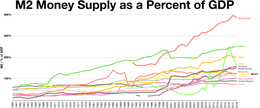
Back Geldvoorraad Afrikaans معروض نقدي Arabic Pul təklifi Azerbaijani Грашовая маса BE-X-OLD Парична маса Bulgarian Oferta monetària Catalan Peněžní zásoba Czech Pengemængde Danish Geldmenge German Mondispono Esperanto
| Part of a series on |
| Macroeconomics |
|---|
 |
| Public finance |
|---|
 |



In macroeconomics, money supply (or money stock) refers to the total volume of money held by the public at a particular point in time. There are several ways to define "money", but standard measures usually include currency in circulation (i.e. physical cash) and demand deposits (depositors' easily accessed assets on the books of financial institutions).[1][2] Money supply data is recorded and published, usually by the national statistical agency or the central bank of the country. Empirical money supply measures are usually named M1, M2, M3, etc., according to how wide a definition of money they embrace. The precise definitions vary from country to country, in part depending on national financial institutional traditions.
Even for narrow aggregates like M1, by far the largest part of the money supply consists of deposits in commercial banks, whereas currency (banknotes and coins) issued by central banks only makes up a small part of the total money supply in modern economies. The public's demand for currency and bank deposits and commercial banks' supply of loans are consequently important determinants of money supply changes. As these decisions are influenced by central banks' monetary policy, not least their setting of interest rates, the money supply is ultimately determined by complex interactions between non-banks, commercial banks and central banks.
According to the quantity theory supported by the monetarist school of thought, there is a tight causal connection between growth in the money supply and inflation. In particular during the 1970s and 1980s this idea was influential, and several major central banks during that period attempted to control the money supply closely, following a monetary policy target of increasing the money supply stably. However, the strategy was generally found to be impractical because money demand turned out to be too unstable for the strategy to work as intended.
Consequently, the money supply has lost its central role in monetary policy, and central banks today generally do not try to control the money supply. Instead they focus on adjusting interest rates, in developed countries normally as part of a direct inflation target which leaves little room for a special emphasis on the money supply. Money supply measures may still play a role in monetary policy, however, as one of many economic indicators that central bankers monitor to judge likely future movements in central variables like employment and inflation.
- ^ Alan Deardorff. "Money supply," Deardorff's Glossary of International Economics
- ^ Karl Brunner, "money supply," The New Palgrave: A Dictionary of Economics, v. 3, p. 527.